Holiday Marketing Trends of the Past and Adapting to the Present
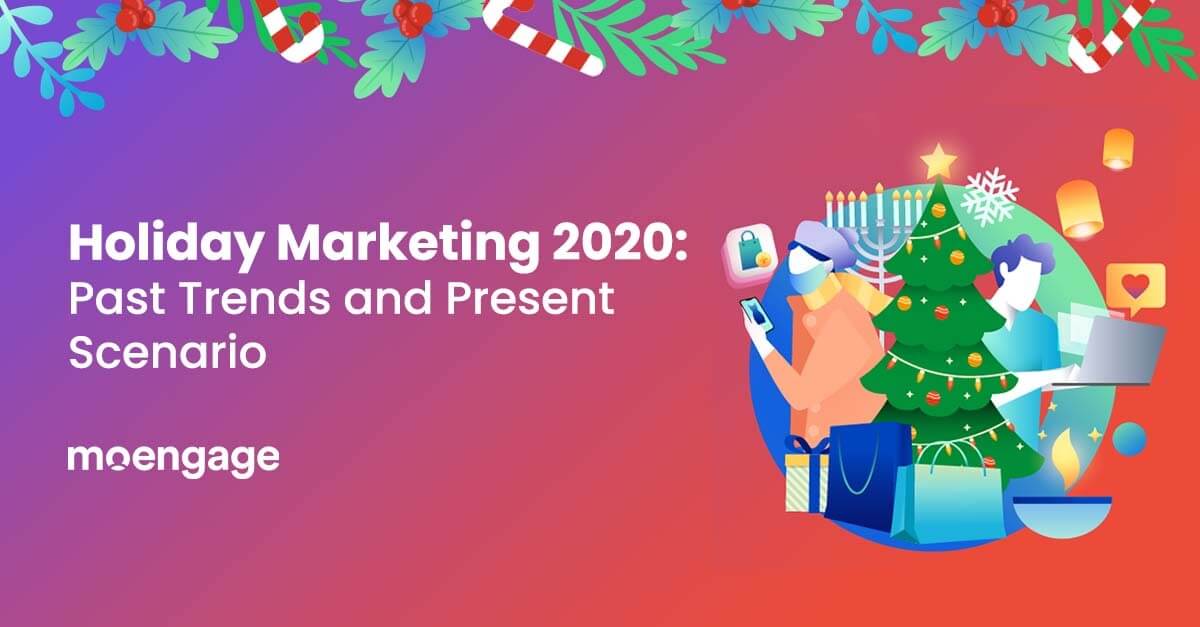
Reading Time: 8 minutes
The holiday season is a special time that’s warm, comforting, and familiar. Gifts, wrapping paper, tinsel, and twinkling lights bring joy to millions around the world, year after year.
While some traditions will stay the same, many will change. With millions of people adapting to a new normal and businesses adjusting to restrictions, this holiday season is very different. This means Holiday traditions and gift-giving may look very different this year. While framing campaigns, you need to be aware of the holiday marketing trends and add value to consumers’ lives. Help them stay connected to who or what they care about most.
In 2020, holiday season sales for retail and e-commerce surpassed the trillion-dollar mark for the first time ever. Despite the unprecedented pandemic and the unusual holiday, with the right strategy you can still grow and earn profits. Forrester expects e-commerce sales to grow by 18.5% this year.
To help you navigate this unusual holiday season, we at MoEngage in collaboration with AppFollow have released a guide with:
- Expert insights and examples of highly successful campaigns from global brands
- Holiday marketing trends for 2020
- Do’s and don’ts while framing holiday strategy and
- 20 actionable strategies you can implement right away
Before you download the guide, let’s explore past festive seasons, holiday marketing trends, and how has it changed. We can begin by looking at the biggest shopping events around the world, campaigns run, and performances.
Festive seasons across geographies
The United States and Europe: Brands being campaign planning from late October, around Halloween. Although Black Friday and Cyber Monday originated in the United States, they are widely popular in Europe too.
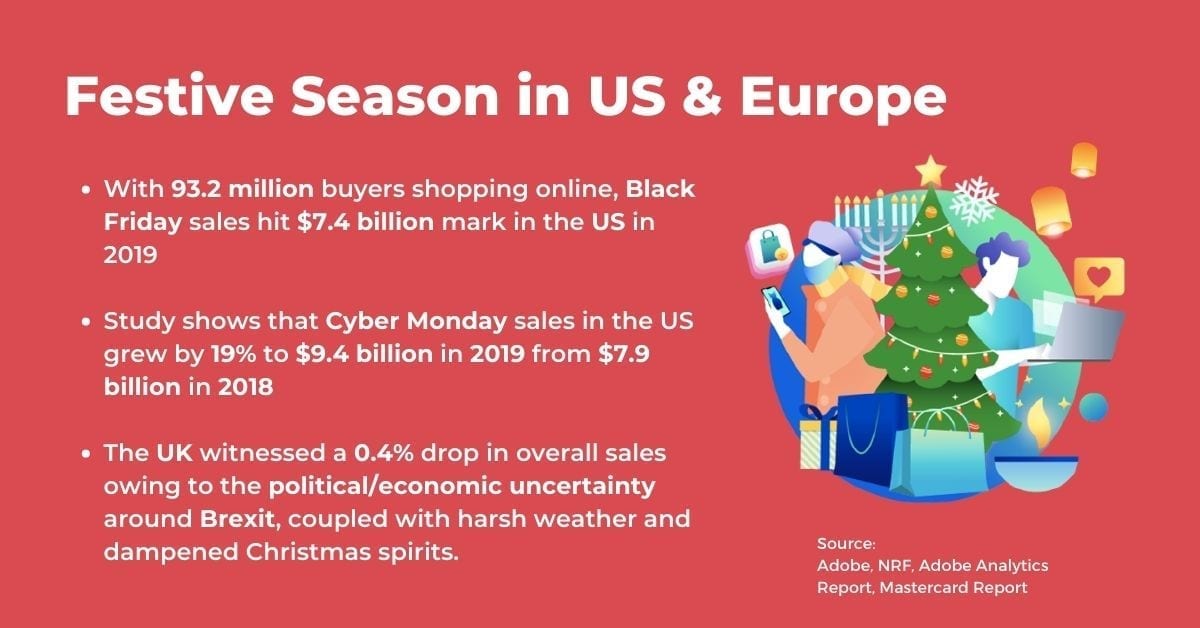
- Black Friday: Held on the day after Thanksgiving, it’s one of the most awaited shopping days with unbelievable offers.
- Cyber Monday: Held on the Monday following Thanksgiving. Brands like Walmart, Amazon, and Target offer numerous deals on iPads, GoPros, televisions, etc.
- Christmas and New Year Sale: One of the biggest sale periods of the year extending from Christmas week to New Year’s eve. Holiday retail sales were up by 3.4% in the US, while e-commerce sales increased by 18.8% compared to 2018.
- Boxing day: Largest post-Christmas shopping event of the year. Presents an opportunity for retailers to clear inventory. Although on a decline, brick-and-mortar stores like John Lewis and Marks & Spencer witnessed an increase in traffic.
Bonus Content
|
India: Traditionally, India’s offline sales have always peaked during Dussehra and Diwali.
According to a Mastercard report in 2019 overall retail sales grew by 3.4% year-on-year, while online sales increased by 18.8%!
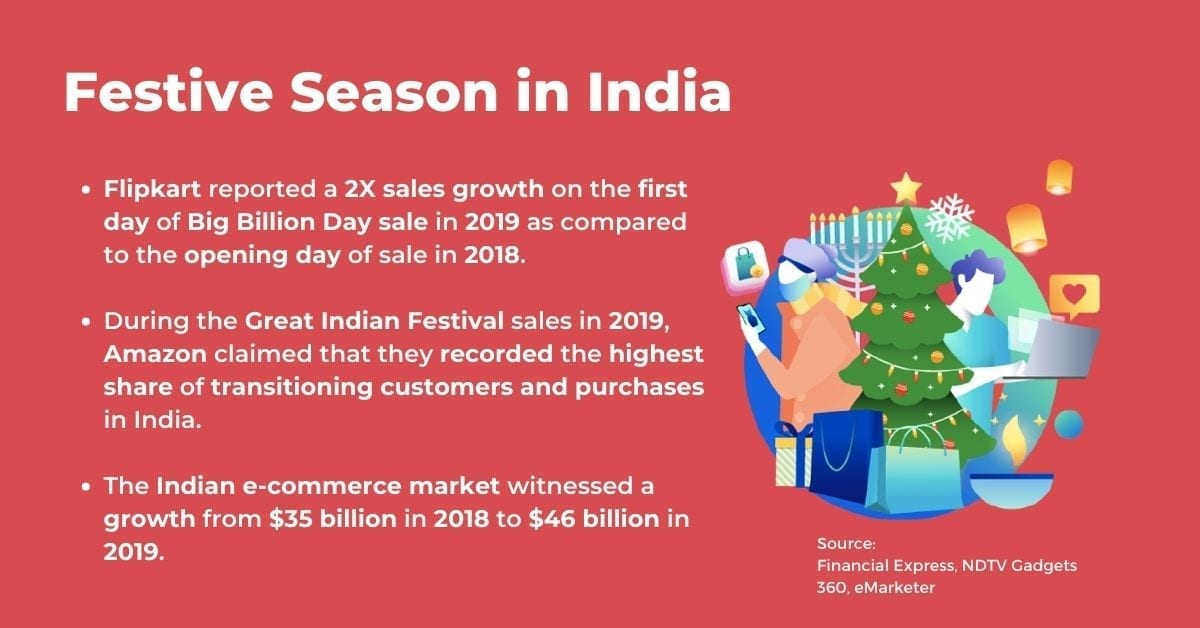
- Flipkart’s Big Billion Day Sale: Flash sales, new deals every 8 hours, discounts on apparel, electronics, and large appliances.
- Amazon’s Great Indian Festival Sale: Big discounts and exclusive deals on mobile phones, home appliances, gadgets, accessories, fashion, and footwear.
- Christmas and New Year Sale: Travel & hospitality, and e-commerce/retail industries have their own online and offline sales at the end of the year, with brands like H&M, Nykaa, IndiGo leading the play.
Middle East: Burgeoning e-commerce brands, powered by digitization and key acquisitions such as that of Souq by Amazon, have changed the landscape in the Middle East, reinventing the way people shop.
According to a Bain prediction, e-commerce in the region is expected to be worth $28.5 billion by 2022.
White Wednesday draws huge crowds through buy-one-get-one offers and attractive discounts. Consumers in Saudi Arabia and Egypt are major drivers, contributing a 30-35% spike in sales every year.
Southeast Asia: Nearly 40% of the online sales in Southeast Asia occur between October and December. Shoppers are open to purchasing from multiple brands and platforms.
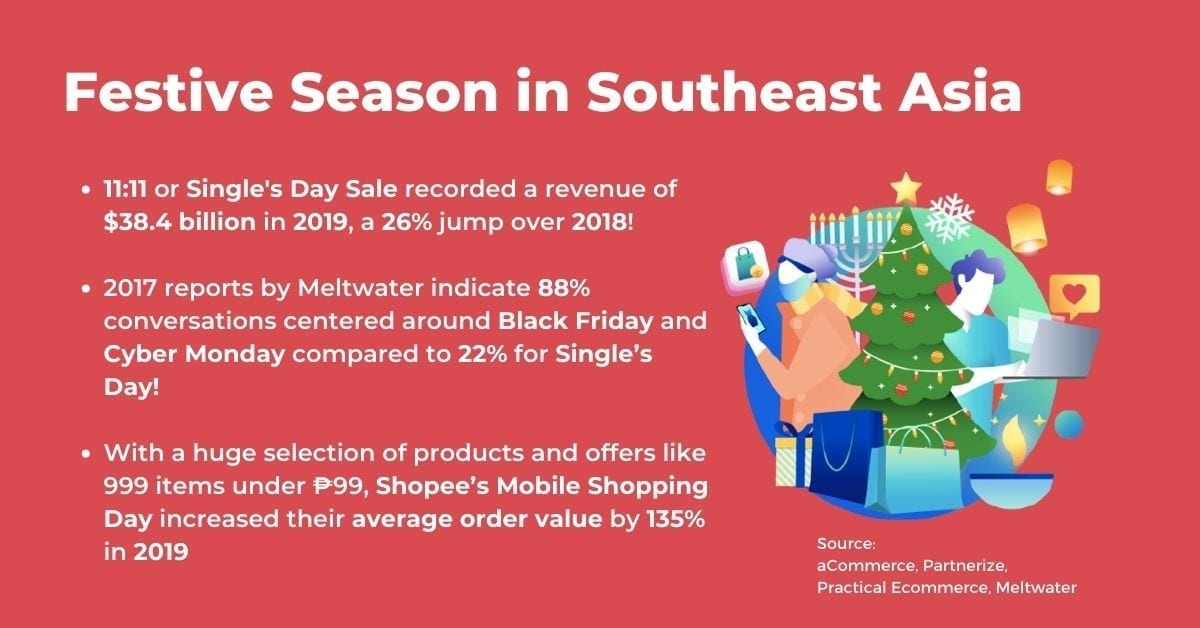
- 11:11 (Single’s Day Sale): Started by Alibaba in November 2009, this 24-hour shopping event has become a global phenomenon.
- Black Friday and Cyber Monday Sale: Generates a lot of buzz and dominates social media chatter across Singapore, Malaysia, and Indonesia.
- Harbolnas: Analogous to Black Friday campaigns and Cyber Monday sales in the west, Harbolnas (Hari Belanja Online Nasional) or National Online Shopping Day, held in December every year, is Indonesia’s single biggest annual shopping event.
Australia and New Zealand: Actual holiday sales in Australia hit $7 billion for the first time in 2019. Shoppers in New Zealand have been warming up to Black Friday spending.
NZ Online Shopper Survey of 2018 revealed that 44% of shoppers admitted to shopping more than what they normally would, resulting in a 10.4% increase year-on-year in retail spends on Black Friday.
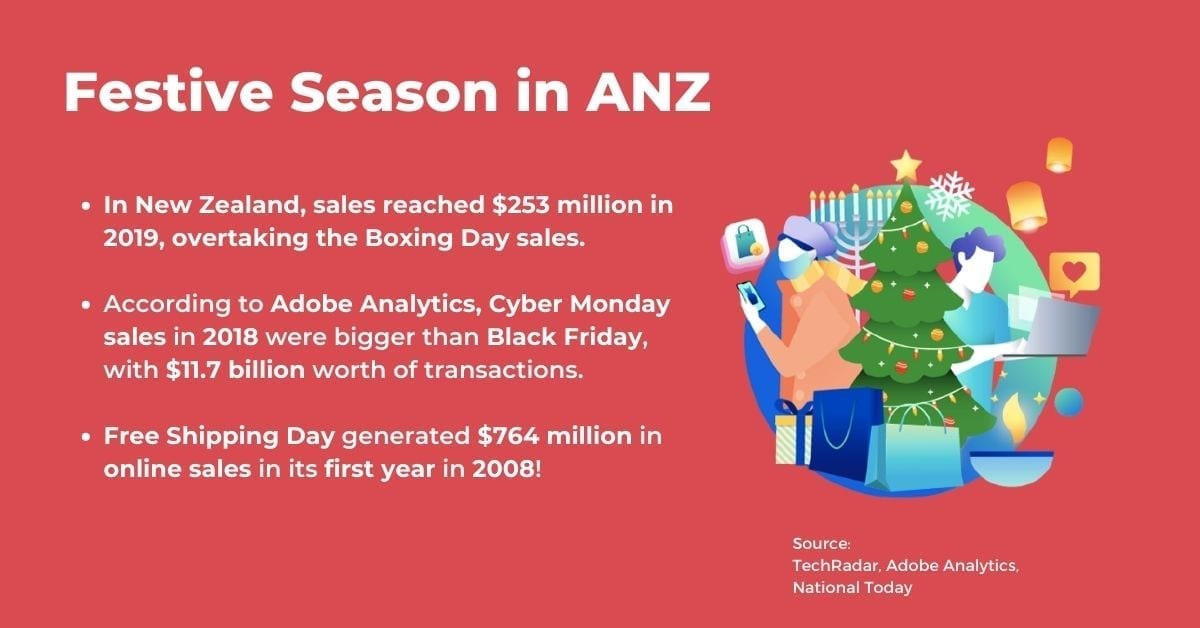
- Black Friday: Always bigger and better each year, research in 2019 has shown that Australians will spend $3.9 billion during this sale.
- Cyber Monday: Great value offers across fashion, electronics and gadgets, travel, and more are the highlights of this sale.
- Free Shipping Day: Held on December 14th, all products are shipped without any additional charges.
Previous campaign performances across geographies and categories
Holiday season 2020 is unlike any other owing to the pandemic and the ensuing crisis. However, to give you an idea of what to expect, here’s a brief overview of holiday marketing campaign numbers in the past along with key data points and trends:
- In India, online shopping searches peak 2-3 weeks before Diwali with sites witnessing a 30% increase in their traffic during the holiday season. Interestingly, non-metro consumers are participating more enthusiastically in online shopping.
- Apparel, accessories, and mobile phones are leading products purchased by consumers.
According to Google’s Consumer Barometer stats of 2017, 41% of Singaporean shoppers research online but shop offline. Offline retailers thus launch more in-store-only discounts and offer to attract online shoppers.
- In Indonesia, although Ramadan is considered the biggest festival, marketers have been using the upcoming holiday season as an opportunity to grow sales. Apparels and accessories feature among the top searches during the holiday season.
- In the Philippines, online shopping searches have increased by 57% in 2018 over 2017.
- Apparel, footwear, food, and personal care are the leading categories for shopping. The shoppers are more focused on gifts that have utility and provide value for money.
- Over the last decade, the Middle East has shown a steady increase in shopping around Christmas and New Year.
A 2019 Salesforce report showed that 76% of shoppers in UAE made holiday purchases from online marketplaces and 48% used Instagram as their main source of inspiration. Offline sales continue to remain relevant with 56% of shoppers purchasing products online but preferring in-store pickup.
- In the US, 30% of all retail sales occur between Black Friday and Christmas. Black Friday witnessed a surge in sales, with 93.2 million buyers in 2019, 50.4% of whom were women, with millennials spending the most.
- In Europe, Christmas retail was most extravagant in the United Kingdom and Germany with an average Christmas budget amounting to €461. The United Kingdom, Spain, and Germany were the biggest spenders with a year-on-year increase in online retail sales with apparel, consumer electronics, toys, and games as popular products.
According to the Inside Australian Online Shopping Industry Report, the holiday season accounted for 15% of all e-commerce transactions in 2018. Fashion, health and beauty, and homeware and appliances are among the leading products purchased online.
- In New Zealand, nearly 60% of consumers planned to shop online for Christmas in 2019. A survey by PayPal revealed that discounts are a key attraction for shoppers in Australia. The survey also showed that seven out of ten Australians actively sought online discounts, while 50% waited till the item they wished to purchase was sold at a discounted price.
Holiday marketing trends
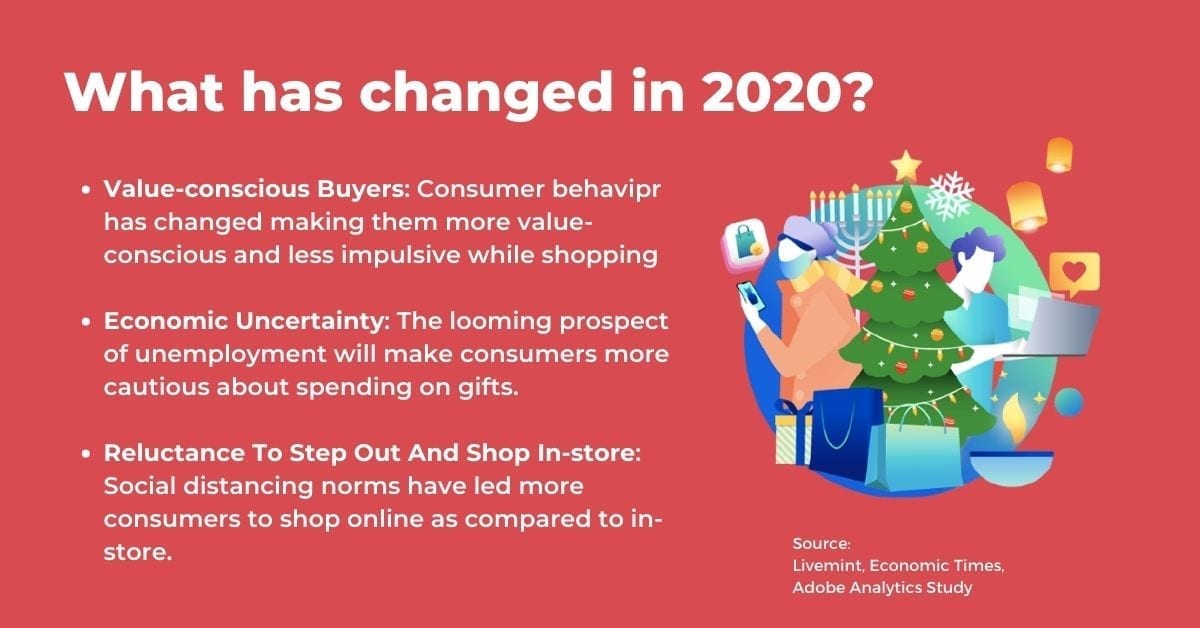
Despite the palpable excitement in the air, holiday seasons seem to be damp this year due to the COVID-19 pandemic. Here are some critical challenges and holiday marketing trends you’ll need to be wary of:
- According to the World Health Organization, nearly half of the global workforce runs the risk of losing their livelihood due to COVID-19. The users would prefer to save money for the future instead of splurging.
- COVID-19 has transformed millennials from swipers to savers. COVID-19 seems to have changed the spending habits of consumers not just in the United States but also in developing countries like India. Consumers will be more value-conscious and less impulsive while shopping. As Chris Farrell, the Marketplace Senior Economics Correspondent, puts it, “More people are embracing frugality or thrift.”
- A holiday season seems incomplete without the images of people lining up outside retail stores as early as midnight to buy their favorite products. However, this year is going to be completely different. A new global study shows that 36% of shoppers now prefer weekly online shopping as compared to the 28% who chose the option pre-COVID-19. This is particularly challenging for brick-and-mortar shops that have relied mainly on in-store sales during the holiday season.
- The disruption in supply chains due to the pandemic badly impacted the retail industry. In April, the retail sales in the United States plunged by 16.4% due to supply chain issues. Problems such as labor shortages, transportation restrictions, and border closures, have added stress on the retail supply chain and led to artificial shortages.
How to adapt holiday marketing strategies for this year?
Based on the above-mentioned holiday marketing trends, it is clear that the changing customer preferences coupled with economic uncertainty and reluctance to step out have affected how users will shop during the holidays. So, how do you adapt your strategies to win this holiday season?
Here are 3 tips for you to keep in mind while framing holiday marketing campaigns
- Keep multiple ad formats ready: It is wise to keep different formats and sizes of creatives ready for various channels. Limiting to the popular format gets you the majority of the impressions, there is high competition resulting in high CPM/CPI. Chances are, different formats, including the least popular sizes get you additional exposure at a much lower price.
Keep testing to discover the most relevant ads for audiences coming in from different channels as they’ll have different expectations. Differentiating through dedicated ad formats for each channel is all the more important in 2020. The online ad space is getting crowded due to the entry of brands that weren’t investing during the pandemic’s peak. There are also newcomers who have recently moved from offline to online and they’ll go heavy on ad spends. - Cater to the new lifestyle: Due to the pandemic new behavior, habits, attitudes, and lifestyles have emerged. Users are now working, exercising from home. You need to target these new personas by using relevant products. Study your user’s browsing and buying history. Leverage user data and insights to drive holiday deals and campaigns better targeting users.
- Keep up with travel habits: This holiday season, people are more likely to take short trips. Families could get away together to spend a portion of the holidays at a place other than their home. These short trips might have a positive end-of-year effect on hotels, restaurants, and other tourism-related industries.
Stay updated with all of our holiday marketing coverage right here!
Here’s What You Can Do Next
|







